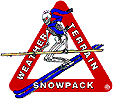Avalanche Terrain 1 Course (also Module 6 of Level 1)
Here is the complete description for this course. This is a mirror of what is posted as part of the course inside dokeos. All of the instructional details are included - the narrative description, topics, specific objectives, outline, assessment information, resources available, and course material information.
Since this course is presented online at your own pace and has assessments we can guarantee that nothing will be left out. There are no time constraints, no outside factors that may require shortening the course or omitting anything, and no way to complete the course without passing the numerous short assessments. We can guarantee that everything posted below will be exactly as stated here.
Course description
This is now available as a stand-alone course based on what was originally available only as Module 6 of the full Level 1 Avalanche course![]() . It is the only terrain module in the Level 1 course.
. It is the only terrain module in the Level 1 course.
This course has four sections. The first covers the relationship between terrain and consequences. The second section covers the physical geography elements of slope angle, compass aspect and slope profile. The third section addresses the importance of vegetation, both as an indicator of activity and its role in anchoring the snowpack. (There are also short introduction and conclusion sections.)
This course itself involves no fieldwork. However, it is a prerequisite in the Level 1 course for the field day, along with a number of other modules. The only prerequisite for this module is Module 1 - Preliminary Background Material. If you are taking this as a stand-alone course that is included.
The focus is on recognizing avalanche terrain and on good routefinding, and especially on proper consideration of terrain when planning an outing. These are topics which will be emphasized during both Level 1 field days, and a skill that continues to be acquired and refined with experience beyond any formal course.
Topics
The first short section introduces the course and workbook.
The main module covers four general topics:
- Terrain and Consequences
- Slope Angle, Aspect and Profile
- Vegetation
- Route Selection and Routefinding
The concluding section wraps up the course and encourages plans for further learning.
Each of these is broken down further into sub-topics within the course, the Outline on this page shows more detail.
Objectives
- Discuss terrain and consequences, including the role of the danger scale
- List and describe key properties and indicators of avalanche terrain
- Identify active avalanche paths, terrain traps and inherently safe areas/routes
- Recognize starting zones, including multiple and secondary ones
- Explain the role of vegetation in anchoring and in indicating avalanche paths
- Find and recognize good routes in the field
- Properly consider terrain factors in the planning phase of a trip
Outline
Terrain 1 Module - Outline
Welcome,
Instructions
Introduction
Terrain and Consequences
- Danger Ratings vs. Consequences
- Snow Climate and Consequences
- Terrain Factors and Consequences
Slope Angle, Aspect, and Profile
- Slope Parameters
- Measuring Slope Angle
Vegetation
- Vegetation Indications
- Snowpack Anchoring
Route Selection and Routefinding
- Routefinding
- Case Study #1
- Case Study #2
- Case Study #3
- Case Study #4
- Case Study #5
- Snowy Torrents Excerpts
Wrap-Up
- Review
- Course Evaluation
Assessments
There are quizzes incorporated into this course which allow students to check their understanding of the material. Quizzes may be taken as many times as desired, either to obtain a passing score or just to attempt to ultimately get a perfect score.
All assessments are taken and scored online in this module/course.
Successful completion of this module requires passing all assessments.
Human and technical Resources
This module has complete access to human resources and technical support. There are numerous ways to contact an instructor and to interact with other students. The module has its own forum for questions and discussion, there is a dropbox for sending documents (including messages) to other students in the module and/or an instructor, there is a messaging system accessed from the top of the web interface, and there is always email.
Major web browsers are supported, others - including phones - are not. At least officially. Find a computer and a good place to study without distractions. If you encounter technical problems with Dokeos or with a major browser we will address the problem promptly. If we are unable to we will offer a refund. This does not apply if you are using an unsupported browser or a phone.
We will note that some students have been able to use a phone for our courses or parts of them. It may work. We just will not guarantee that, and if it does not then we will not make much effort at support.
Course material
Most of the materials in this module were created specifically for this course. Some diagrams originated in the AlpenPro workbook used in traditional courses and some come from the Avalanche Center website.
There is a workbook which can be printed in pieces as the student progresses through the course. These contain primarily copies of diagrams and figures used online as well as space for taking any notes. There may be a limited amount of additional material in the workbook which is not presented online. The workbook is provided so that students who print it will have a reference following the course, it supplements the course and is not a stand-alone book.
Links are provided to external resources where appropriate.
There are no video lectures, we do not teach using recorded lectures.

 Avalanche Institute Home
Avalanche Institute Home